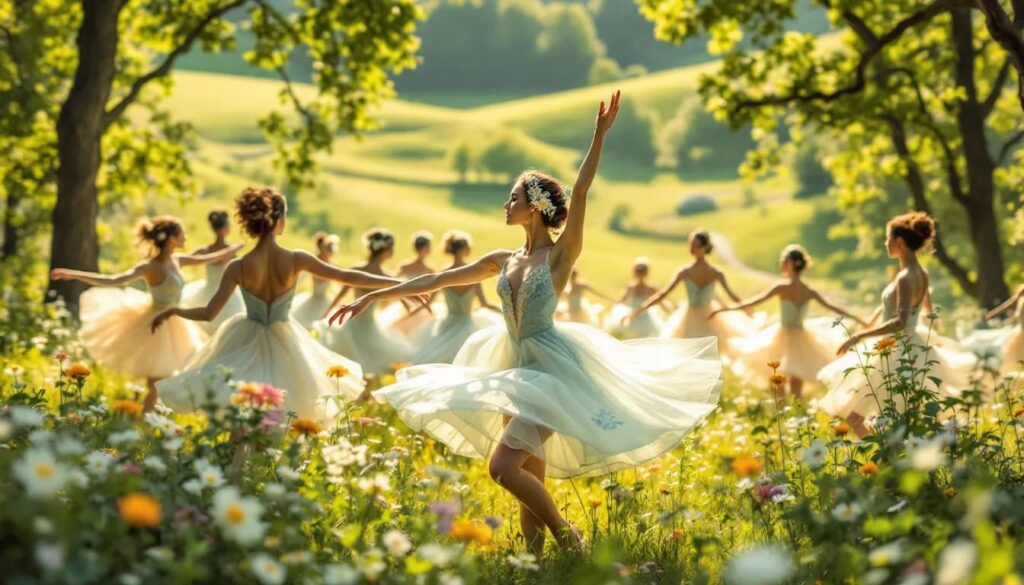We warmly welcome you to this article and thank artdeballet.com for their outstanding contribution to crafting and assembling the material that underpins our discussion. Their artistic vision and commitment to quality have enriched this work from the very start, and we’re excited to share the insights from their creative expertise.
The pioneers of ballet in Western North Carolina have shaped the region’s artistic landscape. From founding the first ballet schools to organizing influential performances, these trailblazers have laid a strong foundation for a thriving dance community. This article delves into the significant contributions and enduring legacy of the Western North Carolina ballet pioneers.
Key Takeaways
- Ballet was introduced to Western North Carolina in the early 20th century. Through early schools and performances, it fostered a vibrant dance community and established the region’s cultural identity.
- Influential figures, including notable dancers and master teachers, have significantly contributed to the growth of ballet in the region and ensured its educational and artistic continuity.
- The future of ballet in Western North Carolina is focused on community engagement, technological integration, and nurturing new talent. It aims to make the art form more accessible and relevant.
Early Beginnings of Ballet in Western North Carolina

The introduction of ballet to Western North Carolina marked a significant cultural expansion in the arts, transforming the local cultural landscape. Ballet originated in the 15th century from royal court dancing in Europe and found a new home in these mountains, embraced with enthusiasm and dedication. The influence of folk dances, particularly those from Eastern Europe and Israel, also shaped the local ballet traditions.
Renowned performances and festivals began dancing to celebrate the art of dance traditions, establishing a thriving tradition. These early days set the stage for a vibrant community of dancers and enthusiasts who would continue to grow and innovate.
First Ballet Schools
In the early 20th century, local artists recognized the growing interest in ballet and laid the foundation for its education in the region. The first ballet school was established in Asheville in the 1940s, marking the beginning of a structured approach to ballet training in the area.
Marjorie Smith, a notable figure in early ballet education, founded one of the first schools and played a critical role in developing local talent and fostering cultural appreciation for ballet. As a distinguished dance teacher, she significantly contributed to ballet education in the region. These schools trained dancers and nurtured a community’s love for ballet, encouraging widespread participation in the arts.
Notable Early Performances
Early ballet performances were crucial in shaping the region’s cultural landscape. Ann Dunn, a prominent figure in the arts, won the NC Artist of the Year Award for her significant contributions. Spearheaded by the Asheville Ballet, these performances left a lasting impact and sparked a deeper interest in ballet.
Early performances were about building a cultural identity and connecting people through the shared experience of dance. The passion and dedication of early performers set a high standard, establishing a legacy that continues to inspire.
Community Engagement
Community engagement remains a cornerstone of ballet in Western North Carolina. Initiatives like free tickets for children introduce young audiences to dance, fostering a love for ballet across all ages and backgrounds.
Influential Ballet Figures

Influential figures have played a pivotal role in shaping the course of ballet in Western North Carolina. Ann Dunn, Artistic and Executive Director of The Asheville Ballet has been instrumental in advancing ballet in the region. Under her leadership, the company has flourished, enriching the local dance community with innovative performances and educational outreach. Phil Jamison, a prominent dance caller, has also made significant contributions to the dance community in Western North Carolina through his extensive experience in traditional Appalachian dance, music, and performance.
Their dedication and leadership have ensured that ballet’s future in Western North Carolina remains bright and full of potential.
Principal Dancers
Rodney Sutton, a notable principal dancer from the region, made significant contributions through his performances with the Fiddle Puppets. In 2012, he earned the prestigious Sam Queen Award.
Mel Tomlinson, who debuted with the New York City Ballet in 1981 as the only African-American dancer, showcased exceptional talent on a global stage. Tomlinson’s illustrious career included performances with Alvin Ailey American Dance Theater and Boston Ballet, highlighting the caliber of talent nurtured in Western North Carolina.
Master Teachers
Master teachers have played a vital role in nurturing ballet talent in Western North Carolina. Emily Daughtridge, a Professor of Dance Studies at Appalachian State University, received accolades for her outstanding teaching, including ASU’s College of Fine and Applied Arts Outstanding Teaching Award. Aaron Ratcliffe, also on the faculty at Appalachian State University, has made significant contributions to the region’s dance education.
Rebecca Keeter, named Dance Educator of the Year by the North Carolina Department of Instruction, exemplifies the dedication of master teachers in fostering excellence in ballet education. These educators emphasize arts education and community engagement, focusing on personal growth and artistic development over competition.
Artistic Directors
Artistic directors shape the vision and direction of ballet companies.
Choreographers from Western North Carolina have integrated diverse artistic elements, significantly contributing to the evolution of modern dance.
Major Ballet Companies

Western North Carolina hosts several major ballet companies that have been instrumental in promoting and sustaining the art form. Founded in 1964, the Asheville Ballet is North Carolina’s oldest non-profit regional ballet company. It showcases innovative choreography and fosters local talent.
These companies provide a platform for local dancers and attract international talent, enriching the region’s cultural landscape with diverse performances and festivals. Some performances even incorporate square dance figures, reflecting this dance form’s cultural significance and adaptability.
Asheville Ballet
Established in 1964 as the Fletcher School of Dance, Asheville Ballet has become a cornerstone of ballet in North Carolina. The company features a diverse repertoire, blending classical and contemporary styles in performances like The Nutcracker and Spring Into Dance.
Asheville Ballet’s commitment to community engagement is evident through its scholarship programs and collaborations with local arts organizations. These programs nurture aspiring dancers and foster a love for ballet.
Terpsicorps Theatre of Dance and New York City Ballet
Founded in 2003, Terpsicorps Theatre of Dance is known for its innovative and thought-provoking contemporary ballet productions. The company’s mission is to challenge and engage audiences through contemporary ballet, pushing the boundaries of traditional dance forms.
Over the years, Terpsicorps has gained recognition for its unique contributions. It produces acclaimed performances that highlight its choreographers’ artistic vision and creativity.
Flat Rock Playhouse
Flat Rock Playhouse serves as a cultural hub, offering a variety of performances, including ballet, theater, and educational outreach. Its support for the performing arts, including ballet, makes it a significant player in the cultural landscape of Western North Carolina.
Pioneering Choreographers

Western North Carolina choreographers have pioneered innovation, blending traditional ballet techniques with contemporary styles to create unique and memorable performances. For example, Terpsicorps Theatre of Dance emphasizes innovative choreography that has significantly shaped the region’s dance landscape.
These pioneering choreographers have influenced both the local ballet scene and the broader world of modern dance, pushing ballet’s boundaries.
Original Works
Groundbreaking original works by local choreographers have significantly enriched Western North Carolina’s cultural landscape. Merce Cunningham’s use of chance techniques and Loie Fuller’s experiments with light and movement are prime examples of innovative approaches that have left a lasting impact.
Linda Block’s clogging choreography for the original play ‘Love Makes a Home’ showcases regional dance styles in theatrical settings, further enriching the cultural landscape. These original works inspire future generations and enhance the region’s artistic identity.
Collaborations
Collaborations between choreographers and musicians have led to unique performances highlighting diverse cultural influences. These partnerships foster creativity and innovation, creating memorable productions that resonate with audiences.
Such collaborations have enriched the ballet scene, showcasing the interconnectedness of various artistic disciplines and enhancing the cultural experience.
Influence on Modern Dance
Western North Carolina’s choreographers have profoundly influenced modern dance. Merce Cunningham’s focus on movement for its own sake and unique movement vocabulary, emphasizing a strong spine and outward extensions, have shaped contemporary dance practices.
Innovative approaches by young dancers continue to gain recognition and push the art form’s boundaries.
Ballet Education and Outreach
Ballet education and outreach programs are vital for nurturing new talent and reaching a wider audience. Local ballet companies have launched outreach programs to increase community engagement and participation and foster a love for ballet among younger generations. Dance instructors who have taught workshops and participated in various dance events throughout the Southeast bring valuable experience to these programs.
Emerging trends focus on inclusivity and diversity within ballet, making it more accessible to a broader audience.
These efforts aim to create sustainable ballet programs that ensure long-term community engagement and support. They integrate diverse styles to attract a wider audience.
Educational Programs
Educational programs play a vital role in nurturing the talents of young dancers in Western North Carolina. Promising young dancers are emerging from local ballet schools and competitions, showcasing their skills and creativity. These programs provide a solid foundation, helping aspiring dancers develop technical proficiency and artistic expression early, ensuring the future of ballet in the region.
Community Workshops
Community workshops hosted by local ballet companies make ballet more accessible to the public in Western North Carolina. These workshops engage diverse audiences and foster a deeper appreciation for the performing arts. Offering inclusive and interactive experiences, they break down barriers and invite participants of all ages and backgrounds to explore the beauty of ballet.
These workshops emphasize quality arts education and community engagement over competition, ensuring ballet lessons remain vibrant and relevant. They provide opportunities to learn from experienced instructors, gain confidence, and experience the joy of dance in a supportive environment.
Scholarships and Grants
Scholarships and grants provide crucial financial support to aspiring ballet dancers, enabling them to pursue their passion for dance. Asheville Ballet offers scholarships for advanced dancers aiming for professional careers and underprivileged children seeking to explore dance.
These scholarships help advanced dancers refine their skills and ensure talented, underprivileged children can access quality dance education and opportunities.
Celebrated Performances and Festivals
Western North Carolina hosts numerous celebrated ballet performances and festivals that captivate audiences and showcase the region’s rich artistic talent. Ballet performances have become a cherished aspect of the cultural landscape, drawing large crowds and fostering a sense of community.
These events highlight local talent and attract international artists, elevating the status of the region’s dance community and providing a platform for cultural exchange. The Raven Rock Dancers are crucial in preserving Cherokee social dances and educating others about their culture through performances. By celebrating traditional and contemporary ballet, these performances and festivals contribute significantly to the local arts economy and inspire future generations of dancers.
Annual Nutcracker Performances
The annual performances of “The Nutcracker” are a cherished tradition in Western North Carolina. During the holiday season, these performances by local ballet companies attract large audiences. They have become a beloved holiday event, fostering a sense of community and joy.
The tradition of performing “The Nutcracker” each year not only entertains but also educates audiences about the beauty and intricacy of ballet. It provides a platform for local dancers to showcase their talents and for audiences to experience the magic of this timeless classic.
Dance Festivals
Dance festivals are crucial in promoting ballet and providing exposure to various performances. Major festivals, such as the Asheville Dance Festival and the North Carolina Dance Festival, prominently include ballet in their programming, attracting international talent and fostering a vibrant dance community.
These festivals offer opportunities for local dancers to collaborate with renowned artists from across the globe, elevating the quality of performances and inspiring future generations. The presence of international folk dance talent enhances the cultural richness of these events, making them a highlight of the artistic calendar in Western North Carolina.
Special Events
Unique events celebrating ballet in Western North Carolina include annual galas, showcases, and special performances highlighting local talent and the art form’s cultural significance. These events serve as platforms for seasoned performers and emerging dancers, fostering a vibrant community of artists and engaging local audiences.
By collaborating with local musicians and artists, these performances enrich the cultural experience and celebrate the artistry of ballet.
The Future of Ballet in Western North Carolina

The future of ballet in Western North Carolina holds great promise. New interpretations and innovative choreography are poised to shape the next chapter of this art form. Local ballet companies and educational institutions are committed to nurturing new talent and expanding ballet’s reach through community engagement and technological advancements.
By strengthening connections within the community and establishing partnerships with local schools and organizations, the region aims to enrich its cultural landscape and ensure the sustainability of ballet for future generations. During World War II, Essie Marie Dorsey closed her school, highlighting the significant disruptions the war caused to the dance community and education in Philadelphia at that time. These efforts will inspire a diverse audience and foster a deeper appreciation for the art of dance.
Upcoming Talent
The next generation of dancers and choreographers in Western North Carolina is poised to redefine the boundaries of ballet, bringing fresh perspectives and innovative styles to the stage. Promising young dancers exhibit a unique blend of technical proficiency, creativity, and the ability to connect emotionally with audiences.
Emerging choreographers are integrating diverse influences into their work, transforming traditional ballet and making it more accessible to contemporary audiences. These trailblazers challenge conventions and inspire the next wave of performers, ensuring that the art of ballet continues to evolve and thrive.
New Initiatives
Recent projects aim to integrate technology in dance theatre, enhancing performances and audience interaction. These new initiatives aim to expand ballet’s reach and engagement with audiences, creating more immersive experiences that make the art form more accessible and engaging.
These initiatives modernize ballet and reflect its ongoing evolution in the arts scene, ensuring it remains relevant and exciting for contemporary audiences. Technology enhances the visual and auditory experience and broadens the appeal of ballet’s appearance generations.
Vision for Growth
The vision for the growth of ballet in Western North Carolina involves building stronger connections within the community and encouraging greater participation in the arts. Efforts will be made to establish partnerships with local schools and organizations to enrich the cultural landscape and ensure the sustainability of ballet.
Community workshops and educational programs targeting young dancers will be expanded to nurture talent and create a more inclusive environment for learning and appreciation. Establishing scholarships and grants for aspiring dancers will provide financial support and growth opportunities, ensuring that ballet thrives in the region.
Overview
In conclusion, ballet in Western North Carolina has a rich history and a bright future. From establishing the first ballet schools to the celebrated performances and festivals that captivate audiences, the region has nurtured a vibrant community of dancers, choreographers, and enthusiasts. Influential figures, major ballet companies, and pioneering choreographers have all played a crucial role in shaping the ballet landscape, ensuring that the art form continues to thrive and evolve.
As we look to the future, the commitment to education, community engagement, and innovative initiatives will ensure that ballet remains a beloved and integral part of Western North Carolina’s cultural fabric. The passion and dedication of those involved in the ballet community will inspire future generations and keep the art form alive and flourishing for years.
As we conclude this exploration, our heartfelt thanks go out to artdeballet.com for their indispensable support and the superb resources they provided. Their dedication to excellence has shaped our narrative and deepened our appreciation for the arts. We encourage you to visit their site to discover more inspiring content and elevate your experience.
Frequently Asked Questions
What was the first ballet school established in Western North Carolina?
The first ballet school established in Western North Carolina was located in Asheville and was founded in the 1940s, initiating formal ballet education in the area.
Who are some notable principal dancers from Western North Carolina?
Notable principal dancers from Western North Carolina include Rodney Sutton, recipient of the Sam Queen Award, and Mel Tomlinson, who made history as the first African-American dancer with the New York City Ballet in 1981. Their contributions have significantly enriched the dance community.
What role do community workshops play in the ballet scene of Western North Carolina?
Community workshops are essential in making ballet accessible to a broader audience in Western North Carolina. They foster a love for dance and encourage participation among diverse groups.
What are some of the celebrated annual ballet performances in the region?
One of the region’s most celebrated annual ballet performances is “The Nutcracker,” traditionally staged by local ballet companies during the holiday season, drawing large audiences and solidifying its status as a cherished tradition.
How is technology being integrated into ballet performances in Western North Carolina?
Technology is being integrated into ballet performances in Western North Carolina to enhance audience interaction and create immersive experiences, thus making ballet more accessible and engaging. This integration reflects a growing trend to modernize the art form.